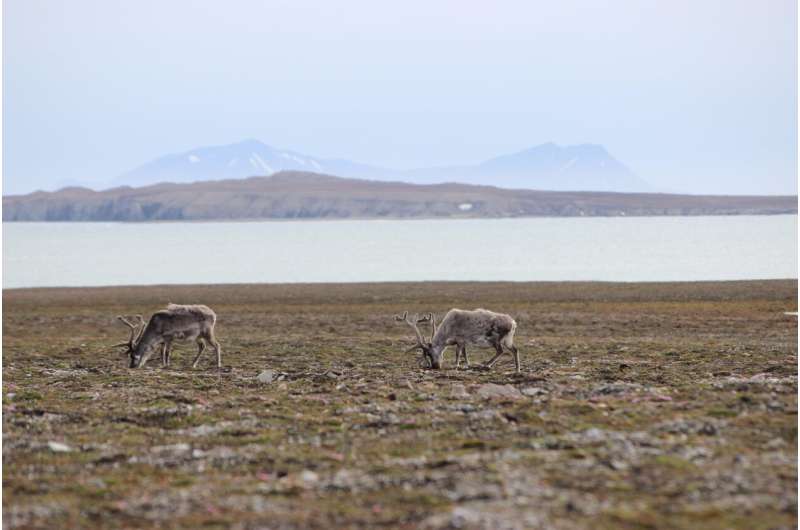This article has been reviewed according to Science X's editorial process and policies. Editors have highlighted the following attributes while ensuring the content's credibility:
fact-checked
peer-reviewed publication
trusted source
proofread
Move over, Blitzen: Geese outpace reindeer impacts on Arctic ecosystems

In the frigid seas halfway between mainland Norway and the North Pole, two types of animals browse the palatable vegetation of a high-tundra archipelago, munching on thick moss, cropped grasses, and low-lying shrubs.
Recent research from a group led by Matteo Petit Bon from the Utah State University Quinney College of Natural Resources is working to untangle the ecosystem impacts that two major players—geese and reindeer—have on a changing and vulnerable Arctic system.
The work is published in the Journal of Ecology.
Reindeer have been year-round residents on the islands of Svalbard for thousands of years, but at one point were almost completely gone. Svalbard reindeer, unlike their southern cousins, tend to be docile and extremely sedentary, making them easy targets for hunting.
Miners, trappers, and overwintering sailing expeditions relied on reindeer for food, and by 1900, the animals were more or less locally extirpated, although a few isolated areas had small populations persist, according to Mathilde Le Moullec, a co-author on the study from the Centre for Biodiversity Dynamics at the Norwegian University of Science and Technology.
Those few reindeer were important, however, because they provided a population to slowly recolonize after the Norwegian government extended full protection to the animals. Now, reindeer populations on Svalbard have expanded to over 20,000 animals.
Barnacle geese make a temporary but essential home on Svalbard at the end of their long migratory journey, said Karen Beard, co-author of the research from the Department of Wildland Resources. Their time on the islands is fundamental to their life cycle, as they take advantage of the seasonal 24-hour light and nutrient-rich vegetation to raise young during a hospitable season in an otherwise very tough environment.
These two heavy-hitting herbivores influence the composition of vegetation on Svalbard in both direct and indirect ways—from the removal of certain plant species to natural fertilization and the compaction of soil through trampling. The way these animals interact with their landscape has complex repercussions for how the ecosystem will respond to climate change in the future, she said.
The Arctic climate is shifting faster than other places under global climate change, and Svalbard is one of the most rapidly warming regions on Earth, said Petit Bon. But life over the last half-century has been relatively good for populations of Svalbard geese.
Conservation policies in their overwintering home in Scotland and changes in climate have led to impressive population expansion—from under 3,000 birds in 1960 to more than 40,000 birds today. Since this growing population has the potential to change the face of the landscape in Svalbard, it's important to understand the ways the geese can impact the land, he said.
Geese are voracious eaters and maintain very low levels of plant biomass, where they graze in concentrated patches. The impact that geese exert on the Svalbard tundra appears to be increasing over time—in 2018, peak summer grass biomass in goose-grazed tundra was five times lower than researchers found in 2008, according to the research.
The geese, who live and eat in concentrated groups, had a bigger impact on the ecosystem than did reindeer, who are much larger animals but more widely dispersed. This likely reflects inherent differences in both habitat sensitivity and the way that the habitats are used by the different herbivores, as well as the way they move and eat, said Petit Bon.
Experimental long-term removal of reindeer from a portion of the island had little evident effect on the ecosystem's health, said the researchers, but the experimental exclusion of geese made a big difference for vegetation and soils. Although geese are obviously considerably smaller in size and are temporary residents, the way they use the landscape creates a heavy-weight impact—bigger even than populations of reindeer.
This research provides important information to aid projections about the effects of shifting herbivore populations on ecosystem functioning, said Beard, and helps to refine predictions on whether and where these shifts are likely to mitigate or further amplify the impact of climate change on Arctic ecosystems.
More information: Matteo Petit Bon et al, Long‐term herbivore removal experiments reveal how geese and reindeer shape vegetation and ecosystem CO2‐fluxes in high‐Arctic tundra, Journal of Ecology (2023). DOI: 10.1111/1365-2745.14200
Journal information: Journal of Ecology
Provided by Utah State University




















